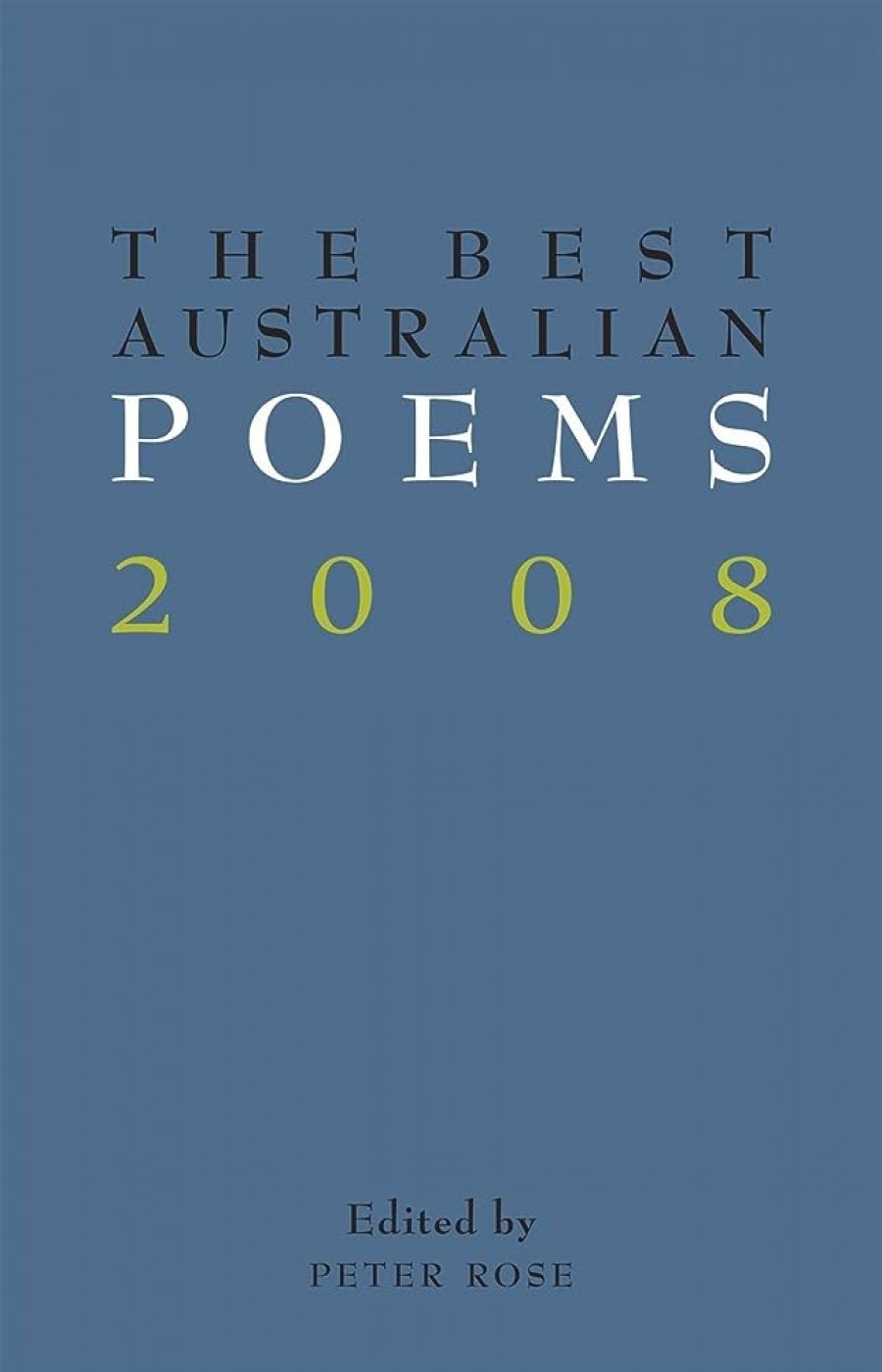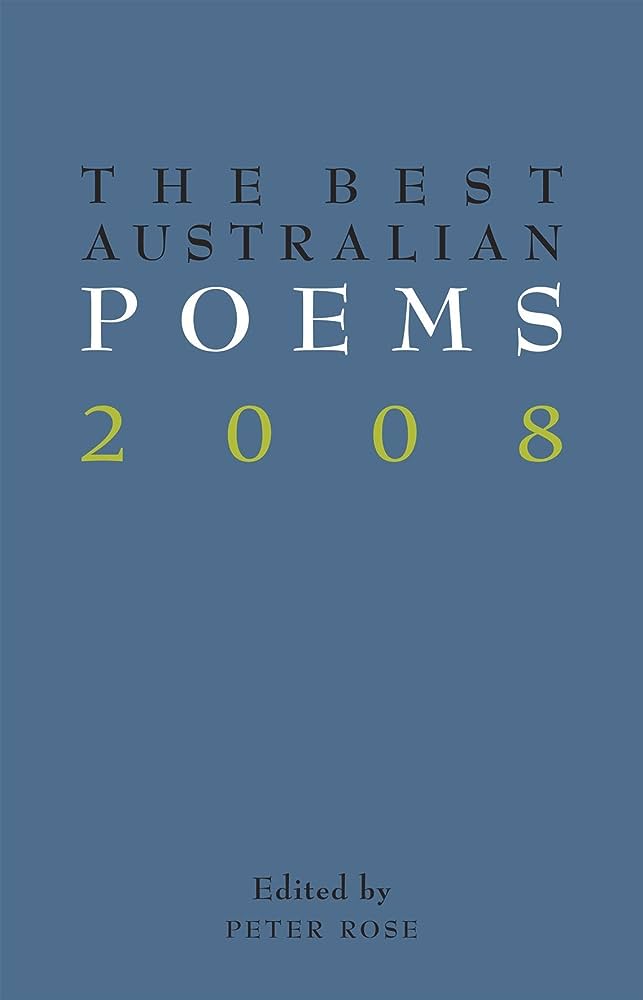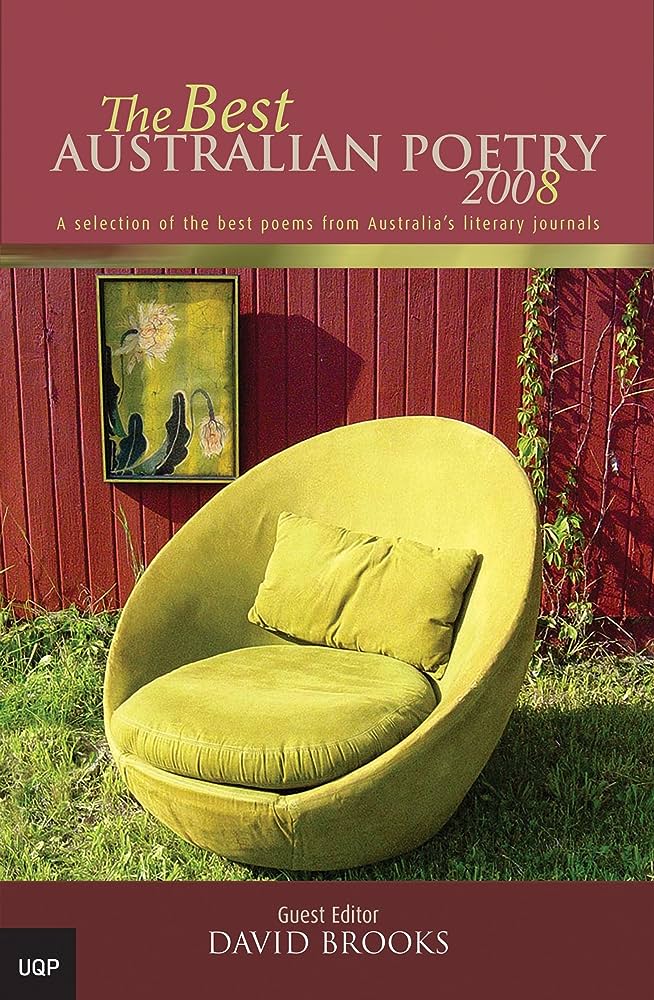
- Free Article: No
- Contents Category: Australian Poetry
- Review Article: Yes
- Article Title: Brace of the best
- Online Only: No
- Custom Highlight Text:
A poet friend, getting wind that I was reviewing the two latest ‘Bests’ and wishing to satirise the reviewing platitudes that sometimes greet the arrival of such anthologies, offered the following advice: ‘Remember to say that both collections are a welcome addition to the literary landscape and that both editors have included some welcome new voices in Australian poetry.’ Peter Rose’s The Best Australian Poems 2008 and David Brooks’s The Best Australian Poetry 2008 provide commendable surveys of a year in Australian poetry. Both include ‘new voices’ as well as sonorous old ones. Variations in quality inevitably occur, but many of the ‘new’ offerings are excellent and few, if any, are duds. This can only be welcomed.
- Book 1 Title: The Best Australian Poems 2008
- Book 1 Biblio: Black Inc., $24.95 pb, 181 pp
- Book 1 Cover Small (400 x 600):

- Book 1 Cover (800 x 1200):

- Book 2 Title: The Best Australian Poetry 2008
- Book 2 Biblio: UQP, $24.95 pb, 167 pp
- Book 2 Cover Small (400 x 600):

- Book 2 Cover (800 x 1200):

At risk of further reviewing cliché, both editors are well qualified for the job. In addition to being widely recognised poets, both are long-standing editors of journals of repute – Brooks of Southerly, Rose of ABR. In introductions to their respective anthologies, each demonstrates an intelligent, and necessary, awareness of the problematics of what constitutes ‘the best’. Both appear conscious of the need to engage and extend the boundaries of personal taste in the search for high quality. Both have searched widely in efforts to represent diverse forms and subject matter while mercifully sparing us tick-the-box programmes of inclusiveness.
The guidelines for compiling these anthologies are similar, though not identical. Both draw from journals, magazines and newspapers; the likes of Meanjin, HEAT and ABR figure strongly. But while Brooks, under UQP auspices, has drawn exclusively from Australian publications, Rose, under the Black Inc. moniker, has looked beyond and sourced Australian poetry from eminent overseas publications such as the London Review of Books, the Times Literary Supplement and the New Yorker, as well as the North American journal of Australian literature, Antipodes. This has given Rose manoeuvrability to include strong work from the likes of Les Murray and Peter Porter – ‘two of our most prolific and eminent poets’, as he points out in his introduction – who both happen to be reaching significant life milestones (Murray turning seventy, Porter eighty).
Interestingly, both anthologies include, for the first time, work from online journals as well as those in print. As noted by Rose, and by UQP series editors Bronwyn Lea and Martin Duwell in their foreword, this not only acknowledges the growing significance of the Internet in the pro-mulgation of poetry, but provides greater scope to include longer poems, given that online journals have fewer issues with length. Deserving poems from online journals such as Cordite, foam:e and John Tranter’s enduring Jacket have consequently found homes here. (Rose tellingly notes that, while he found many fine poems on the Internet, ‘The quality and presentation of the poetry struck me as being more variable than in the print sphere’.)
Both editors also restricted their choices to twelve-month periods. Rose, however, draws from September 2007 to August 2008, while, in keeping with the policy established six years previously by the series editors, Brooks’s 2008 UQP anthology draws entirely from 2007. For the numerically minded, and at the risk of emulating stats-obsessed sporting commentators, Rose has included seventy-one contributors, Brooks (again in keeping with the framework established by the series editors) forty. Each editor has restricted himself to one poem per contributor. Thirteen contributors, including Robert Adamson, Dorothy Porter and the astonishingly productive John Kinsella, appear in both anthologies. Sufficient overlap existed in the time frames for eligibility and in the tastes of the editors for three poems – by Geoffrey Lehmann, Jaya Savige and Sarah Tiffen – to appear in both collections.
Tiffen’s ‘Rain Event in the High Country’ is a highly lyrical evocation of the coming of rain in rural New South Wales. The strong imagery, however, flirts with poetic cliché and threatens to be overwhelmed by the mammary secretions of the moonlight flooding the cattle country. Savige’s ‘Circular Breathing’ sees a didgeridoo player performing in Rome’s Piazza di Santa Maria. The poem celebrates the ‘vast, unhurried Om’ while regretting the corresponding lack of reception for the instrument – and, by implication, for indigenous culture – ‘at home’. While not at its most subtle in the final stanza, the poem closes with some effective rhyme, and in structure and theme draws on the circularity inherent in the playing of the instrument.
A long poem, Lehmann’s ‘Self-portrait at 62’ achieves a superb day-in-the-life poignancy that fully vindicates its extended presence in both anthologies. Brooks’s anthology continues the UQP tradition of contributor commentary at the rear of the book, and, as Lehmann explains, his poem seeks the kind of self-portrait in words that visual artists achieve in paint. The poem is, from the outset, disarmingly honest and direct:
Aged 62, I like what I do.
Minus a prostate, I have erectile dysfunction,
but we make love in our way, and still with fervour within my altered body map.
Physical existence is at times objectified – ‘My body sits in an office tower …’ – while Lehmann’s recurring images of computer screen, foyer, plate glass and phones provide motifs of an office life that remains curiously under-represented in Australian poetry.
As Lea and Duwell observe in their foreword, a number of poems are portraits. Strong examples in Brooks’s selection include Jean Kent’s ‘Mr Stern’ (benevolent head-master who nevertheless lives up to his name), Brendan Ryan’s ‘Woman Wearing a Hairnet’ and Alan Wearne’s play-like ‘Chatswood: Ruth Nash Speaks’. Nor is Lehmann’s the only self-portrait. Jennifer Maiden’s ‘Diary Poem: Uses of Anger’ arguably offers a retort to a critic in the very act of claiming to have resisted such an undertaking, but proceeds in crackling good humour:
… God, when
I was twenty I was extremely post-
modernist and the reader wrote the text.
I even wrote that blank section
in Tristram Shandy on romantic love.
Not long after, the poet is left lamenting that ‘my baby wasn’t mine. Many Frenchmen / seemed very good at creating my ideas / shortly after me’. Still in Brooks’s collection, Jill Jones’s cryptic ‘The Thought of an Autobiographical Poem Troubles & Eludes Me’ provides a nice thematic counterpoint, language and imagery emerging from (as Jones states in her notes) ‘a distant self’.
Despite the preponderance of Australians living urban/suburban lives, pastoral themes continue to have a hold on poetic output. Rural landscape features strongly. Brooks’s collection has a lot of cows. This is not to say that bovine nostalgia governs the poems. Some, such as Sean M. Whelan’s ‘One Hundred Random Cows’ – in which one of the eponymous hoofed kind appears on a billboard – demonstrate ironic self-awareness. Ross Clark’s ‘Full-bucket Moon’ celebrates milking, the narrator’s brow against ‘the gurgling drum’ of the cow, but also herds muses from classical mythology. Others, such as in the more polemical poem of John Kinsella critiquing land use, constitute the so-called ‘anti-pastoral’. Adamson’s ‘Summer at Carcoar’ pays homage to Brett Whiteley, and the birds and animals around the Belubula River, which in form it maps. Other animals gracing Brooks’s pages include Judith Beveridge’s (literally) explosive ‘Whale’ and, entering the domestic sphere, a rodent running whimsically through Kevin Hart’s ‘The Mouse’. Also notable is Elizabeth Campbell’s ‘Equus’, which critiques metaphor and the anthropomorphic urge, yet is also, unequivocally, about a horse. Perhaps reflecting a fear of nascent sentimentality, few barks or plaintive miaows can be heard. Appropriately, Ken Bolton’s ‘An Australian Suburban Garden’ proves an exception.
Work gathered in collections such as these is necessarily eclectic. A few of the many strong poems in Brooks’s anthology that do not fall within the broad themes identified above include Kathryn Lomer’s moving ‘The Fencer and His Mate’ (though it too harnesses something of the pastoral), the birth of darkness in Felicity Plunkett’s ‘Delivery’, and Nathan Shepherdson’s marvellously wry stacking of chairs in ‘38 Ways to Stain a Memory’.
Peter Rose notes that the elegy was the most characteristic poem of his 2007 anthology. His 2008 collection also includes a number of fine poems that are either elegiac or engage explicitly with death. Of particular note is Lisa Gorton’s ‘Solitaire’ (‘I think I once saw you walking the curve of a disused rail line / where the track shrugged off its sleepers and climbed into the heat’), as well as poems by Anthony Lawrence, Peter Porter, Tracy Ryan and Peter Steele. The journey in Pam Brown’s ‘Train Train’ and the darkness in Stephen Edgar’s ‘Nocturnal’, in very different ways, also invoke mortality.
Rose has made an effort to source work from Australian poetry’s ‘elders’. Yet he hasn’t been blinded by the light, and has worked hard to source the very best recent work by such long-established poets. This includes Clive James’s confidently relaxed vernacular in ‘We Being Ghosts’, Rosemary Dobson’s sublime haiku on ageing in ‘Poems a Long Way after Bashō’ and Chris Wallace-Crabbe’s equally Bashō-like ‘At Long Last’, in which the ‘early birdfoot steps’ of the present moment enter ‘like a large matriculation of ants / rustling their completed exam papers all at once’.
Rose, like Brooks, also makes provision for newer and/or younger poets. Interestingly, despite the higher number of eloquent grandees in Rose, his anthology manages to include also more poems engaging emblems of the contemporary world (granted, Rose’s collection has, simply, more poems all up). James Bradley’s ‘Facebook’, for example, encapsulates the essence of cyber engagement. For that matter, Les Murray provides a swift dismantling of technology in ‘Science Fiction’.
While there are too many poems of high quality to cite, others worthy of special mention from the Rose anthology include Louis Armand’s miscellany of found objects and moments, Ian Gibbins’s field guide to animals and ways of relating, and Judy Johnson’s meditation on the senses.
My poet friend had one other piece of advice: ‘I also believe it’s mandatory to tell readers not to choose between the two anthologies but simply buy both.’ At a time when some politicians and economists tell us that the best way to avoid recession is to spend, you could do worse than lay out your plunging Australian dollars on these books. You might also consider subscribing to the magazines and journals that published the poems originally and helped make these impressive anthologies possible.


Comments powered by CComment